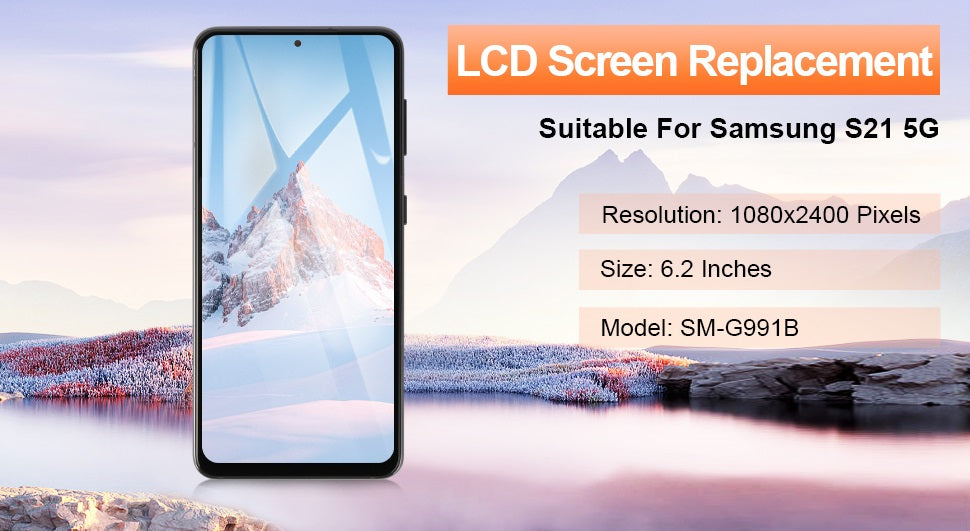
Samsung Galaxy S21 Screen Replacement: A Comprehensive Guide for DIY Repair
Share
Navigating the World of Samsung Galaxy S21 Screen Replacements
The Samsung Galaxy S21 series boasts stunning displays, renowned for their vibrant colors, sharp details, and smooth responsiveness. But a cracked or broken screen can quickly turn your beloved phone into a frustrating eyesore, hindering your ability to enjoy its visual brilliance. Thankfully, replacing a Samsung Galaxy S21 screen isn't as daunting as it might seem. With the right tools, a bit of patience, and this comprehensive guide, you can restore your phone's functionality and visual brilliance without breaking the bank.
Before we dive into the repair process, let's acknowledge the importance of safety. Replacing a Samsung Galaxy S21 screen involves working with delicate components and requires a certain level of technical skill. If you're not comfortable with this type of repair, it's always best to seek professional assistance from a qualified technician. However, for those who are tech-savvy and willing to take on the challenge, we'll guide you through a step-by-step process that empowers you to take control of your repair.
Why Your Samsung Galaxy S21 Screen Might Need Replacing
Several factors can contribute to a cracked or broken Samsung Galaxy S21 screen, each presenting its own set of challenges and necessitating a repair. Understanding the root cause can help you diagnose the issue and choose the appropriate solution.
- Accidental Drops: A slip of the hand or an unexpected fall can easily lead to a cracked screen, a common scenario for many smartphone users. The force of the impact can shatter the glass, damage the underlying display, or disrupt the delicate touch sensors.
- Excessive Pressure: Sitting on your phone or placing heavy objects on it can cause internal pressure, leading to a broken screen. This pressure can distort the screen's internal components, leading to cracks, lines, or even complete display failure.
- Wear and Tear: Over time, normal use can lead to scratches and wear on the screen, eventually causing it to become unresponsive or visually distorted. Scratches can accumulate, affecting the clarity of the display, while excessive wear and tear on the touch sensors can cause them to malfunction, resulting in ghost touches or unresponsive areas.
- Manufacturing Defects: In rare cases, the screen might have manufacturing defects that cause it to malfunction or break prematurely. These defects can manifest as cracks, lines, or unresponsive touch areas, even without any physical impact.
The Importance of Choosing the Right Replacement Screen
The success of your repair hinges on choosing the right replacement screen for your Samsung Galaxy S21. While you might be tempted to go for the cheapest option, remember that a low-quality screen can lead to various issues that can undermine your repair efforts and lead to further complications down the road.
- Poor Image Quality: A low-quality screen might display faded colors, blurry images, and inaccurate color reproduction, diminishing the visual experience that Samsung Galaxy S21 users expect.
- Unresponsive Touch: The touchscreen might become sluggish, unresponsive, or exhibit ghost touch issues, making it difficult to navigate and interact with your phone.
- Reduced Durability: A cheap screen might be more susceptible to scratches, cracks, and other damage, leading to further repairs in the future.
We recommend using a high-quality screen like the AMOLED Display Assembly With Frame for Samsung Galaxy S20. This is an OLED and Touch Screen Assembly Replacement for the Galaxy S20. This replacement screen is very affordable and will help with a non-responsive touch screen, broken display, or a dead pixel. It's compatible with a wide range of Samsung Galaxy S20 models, offering a cost-effective solution for a variety of screen issues.
Assembling Your Toolkit for Success
Before you begin, ensure you have all the necessary tools to make the repair process smooth and efficient. A well-equipped toolkit can prevent unnecessary delays, frustrations, and potential damage.
- New Samsung Galaxy S21 Screen: We've already discussed the importance of choosing a high-quality screen replacement. Ensure you purchase a screen compatible with your specific Samsung Galaxy S21 model. Research the screen's compatibility and specifications to ensure a seamless fit and optimal performance.
- Phillips Head Screwdriver: You'll need this to remove and reattach screws holding the phone's back panel and midframe together. Make sure the screwdriver bit size matches the screws on your device.
- Plastic Opening Tool: This tool is crucial for carefully prying open the phone's back panel and midframe without damaging the delicate components. Choose a plastic opening tool with a smooth edge to avoid scratching or marring the phone's surface.
- Heat Gun or Hairdryer (Optional): A heat gun or hairdryer can help soften the adhesive holding the phone's components together, making them easier to separate. If you choose to use heat, apply it carefully and avoid overheating the phone.
- Small Bowl of Isopropyl Alcohol: Isopropyl alcohol can help clean the phone's components, removing dust, fingerprints, and any adhesive residue. Use a low concentration of isopropyl alcohol (around 70%) to prevent damage to the phone's delicate components.
- Microfiber Cloth: This cloth is ideal for wiping away dust, fingerprints, and any excess isopropyl alcohol. Choose a lint-free microfiber cloth to avoid leaving behind any particles that could interfere with the repair.
- Tweezers: Tweezers can help you grip small components and delicate parts of the phone during the repair process. Choose tweezers with smooth tips to avoid damaging the phone's components.
Step-by-Step Guide to Replacing Your Samsung Galaxy S21 Screen
Now that you have your tools ready, let's embark on the step-by-step process of replacing your Samsung Galaxy S21 screen. Remember to proceed with caution and patience throughout the process, taking your time to ensure a successful and efficient repair.
Step 1: Power Down Your Phone
The first and most important step is to power down your Samsung Galaxy S21 completely. This will prevent any potential damage or electric shock during the repair process.
Step 2: Remove the Back Panel
Locate the screws holding the back panel in place. These screws are typically located around the edges of the phone, near the camera module or the SIM card tray. Use your Phillips head screwdriver to carefully remove these screws.
Once the screws are removed, you can use a plastic opening tool to gently pry open the back panel, starting from one corner.
Work your way around the edges, applying gentle pressure until the back panel comes loose.
Be sure to pry slowly and carefully to avoid damaging the phone's frame.
As you pry, avoid applying excessive force, as this could lead to bending or warping the frame.
Step 3: Disconnect the Battery
After removing the back panel, you'll see the battery connector. Carefully disconnect the battery connector using a plastic opening tool.
This is crucial to prevent any accidental short circuits or damage during the repair process.
When disconnecting the battery, ensure you're only applying pressure to the connector itself, avoiding contact with the phone's board or other components.
Step 4: Removing the Old Screen
This step might require some extra care and attention, as it involves carefully detaching the old screen from the phone's frame.
To access the old screen, you'll likely need to remove the midframe.
Use a plastic opening tool to gently pry open the midframe, starting from one corner.
Be mindful of the phone's delicate components and apply pressure carefully to avoid damage.
Once the midframe is removed, you can carefully detach the old screen.
Before detaching the screen, locate the display and touch sensor connectors. These connectors are typically located near the bottom or top of the screen. Gently lift the screen from the frame, being careful not to put undue pressure on the connectors.
Step 5: Installing the New Screen
With the old screen removed, it's time to install the new screen. Carefully align the new screen with the phone's frame.
Make sure the connectors on the new screen are properly aligned with the phone's board.
Once you're confident the alignment is correct, gently press down on the screen to secure it in place.
Avoid pressing too hard, as this could damage the screen or the phone's frame.
Step 6: Reconnecting the Battery
Now that the new screen is installed, reconnect the battery connector. Carefully align the connector and gently press it down to ensure a secure connection.
Double-check that the connector is securely in place to prevent any issues with the phone's power or performance.
Step 7: Reassembling the Phone
With the new screen in place and the battery reconnected, you can begin reassembling your phone.
Start by carefully aligning the midframe and pressing it down to secure it.
Then, carefully align the back panel and press it down to secure it.
Finally, reattach the screws that hold the back panel in place, ensuring they are tightened securely.
Use your Phillips head screwdriver to tighten the screws to the appropriate torque, avoiding overtightening which could strip the screw or damage the phone's frame.
Step 8: Testing the New Screen
After you've successfully reassembled the phone, power it on and test the new screen thoroughly.
Make sure the touch screen is responsive and works correctly.
Check the display for any lines or distortions.
Ensure the colors are accurate and vibrant.
If you encounter any issues during testing, carefully review your work, paying attention to the connections and alignment of the new screen.
Safety Precautions: A Focus on Mindfulness
Repairing your Samsung Galaxy S21 requires a keen eye for detail and a commitment to safety.
- Ground Yourself: Before working on any electronic device, it's essential to ground yourself. This helps prevent static electricity discharge, which can damage delicate components. You can ground yourself by touching a metal object, such as a radiator or a grounded electrical outlet.
- Clean and Dry Work Area: Work on a clean and dry surface to minimize the risk of dust or debris contaminating your phone's components. Wipe down your work area with a damp cloth to remove any loose particles.
- Gentle Handling: Use a plastic opening tool to avoid scratching or damaging the phone's frame. Avoid bending or twisting the phone during the repair process.
- Patience and Precision: Take your time and proceed with caution throughout the repair process. Pay attention to detail and ensure every component is properly aligned and secured.
Conclusion: Empowering You to Take Control of Your Repair
Replacing a Samsung Galaxy S21 screen can be a rewarding experience, allowing you to fix your phone without relying on costly professional repairs. By following these steps and exercising caution and patience, you can successfully replace your screen and restore your phone's functionality and visual brilliance. Remember, if you're ever unsure or uncomfortable with the repair process, it's always best to seek professional help from a qualified technician.

